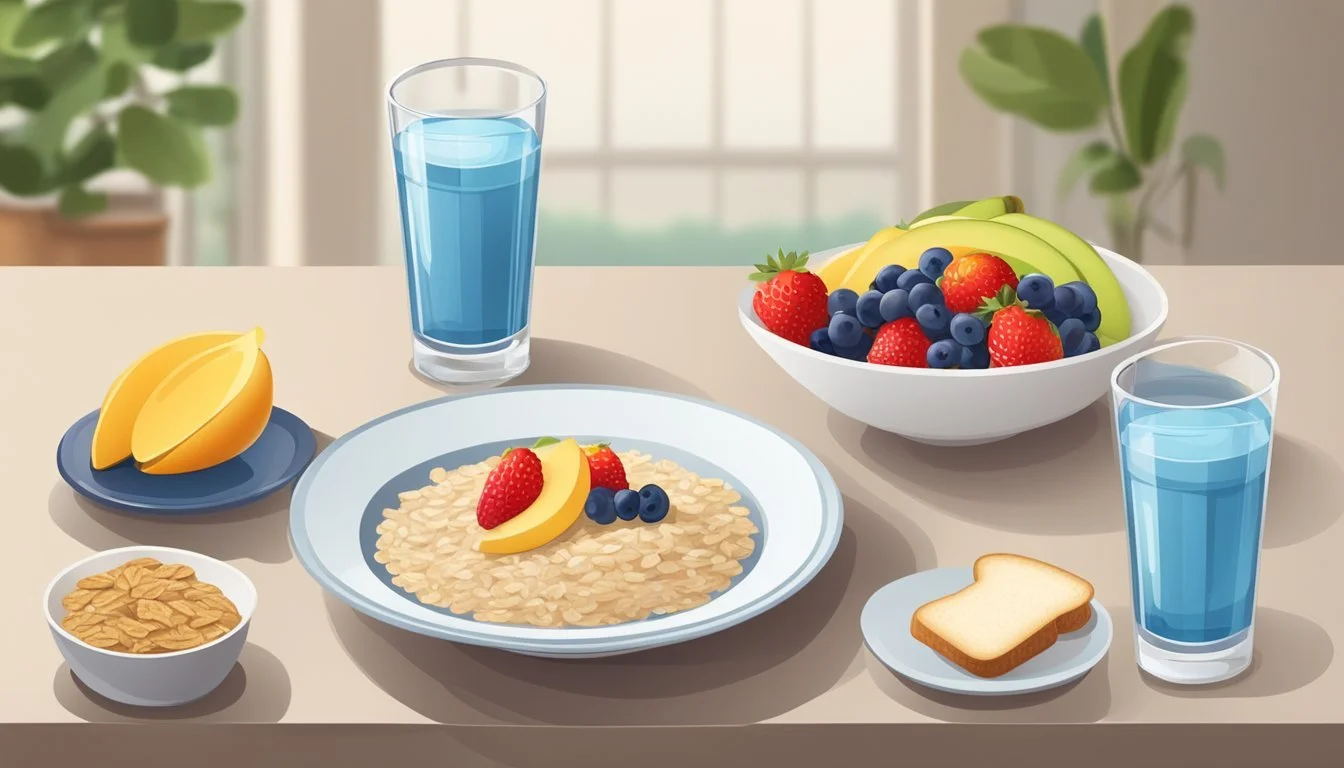Delicious British Breakfast Ideas for Managing Diabetes
Diabetes management starts with a healthy breakfast. For people in the UK living with diabetes, the morning meal plays a crucial role in regulating blood sugar levels and providing sustained energy throughout the day. A well-balanced diabetic breakfast typically includes fiber-rich whole grains, lean proteins, and nutrient-dense fruits or vegetables.
Choosing the right breakfast can make a significant difference in blood glucose control. Low-carb options like scrambled eggs with vegetables or Greek yogurt with berries are popular choices. Alternatively, whole grain cereals with low-fat milk and a serving of fruit can provide a good balance of nutrients while helping to maintain stable blood sugar levels.
UK-specific breakfast ideas for diabetes management include options like grilled tomatoes with eggs on whole grain toast, or roasted mushrooms topped with wilted spinach and soft cheese. These meals combine traditional British breakfast elements with diabetes-friendly nutritional principles, offering tasty and satisfying options for those looking to start their day on a healthy note.
Understanding Diabetes and Breakfast Importance
Breakfast plays a vital role in managing diabetes and maintaining stable blood sugar levels throughout the day. Proper nutrition and meal timing can significantly impact glucose control and overall health for individuals with diabetes.
The Role of Breakfast in Blood Sugar Management
Eating breakfast helps regulate blood glucose levels after the overnight fasting period. For people with diabetes, this morning meal can prevent sharp spikes or drops in blood sugar.
A balanced breakfast provides steady energy and can improve insulin sensitivity. This can lead to better glucose control throughout the day.
Skipping breakfast may cause overeating later, potentially leading to blood sugar fluctuations. Regular breakfast consumption has been linked to improved HbA1c levels in some studies.
Nutritional Considerations for Diabetes
A diabetes-friendly breakfast should include a mix of complex carbohydrates, lean proteins, and healthy fats. Whole grains, such as oats or whole wheat bread, provide fiber and slow-release energy.
Protein sources like eggs, Greek yogurt, or lean meats help with satiety and blood sugar stability. Including vegetables adds essential nutrients and fiber.
Portion control is crucial. Measuring servings helps manage carbohydrate intake and maintain consistent blood glucose levels.
Latest Research and Breakthroughs
Recent studies have explored the impact of breakfast timing on diabetes management. Some research suggests that eating breakfast earlier in the day may improve insulin sensitivity.
Intermittent fasting approaches, including time-restricted feeding, are being investigated for their potential benefits in diabetes management. However, more research is needed to determine long-term effects.
New dietary patterns, such as the Mediterranean diet, show promise in managing diabetes when incorporated into breakfast routines. These diets emphasize whole foods and plant-based options.
Diabetic-Friendly Breakfast Foods
Choosing the right breakfast foods is essential for managing diabetes. The following options provide balanced nutrition while helping to control blood sugar levels.
Recommended Fruits and Berries
Berries are excellent choices for diabetics due to their low glycemic index and high fiber content. Strawberries, blueberries, raspberries, and blackberries are packed with antioxidants and vitamins. These fruits can be enjoyed fresh or added to cereals and yogurt.
Apples, pears, and citrus fruits like oranges and grapefruits are also beneficial. They contain soluble fiber, which slows down digestion and helps regulate blood sugar. It's important to consume whole fruits rather than juices to maintain the fiber content.
Portion control is key. A serving size of about 1 cup of berries or a medium-sized fruit is typically appropriate for most diabetic meal plans.
Best Nuts and Seeds for Diabetes
Nuts and seeds are nutrient-dense foods that can help stabilize blood sugar levels. Almonds, walnuts, and pistachios are particularly beneficial. These nuts are rich in healthy fats, protein, and fiber.
Chia seeds and flaxseeds are excellent sources of omega-3 fatty acids and fiber. They can be sprinkled on cereals or added to smoothies. Pumpkin seeds and sunflower seeds provide magnesium, which may improve insulin sensitivity.
A small handful (about 30g) of nuts or 1-2 tablespoons of seeds is a suitable serving size. While nutritious, these foods are calorie-dense, so moderation is important.
Choosing Dairy and Alternatives
Low-fat or fat-free milk and yogurt can be part of a diabetic-friendly breakfast. These dairy products provide calcium and protein without excessive saturated fat. Greek yogurt is particularly beneficial due to its higher protein content.
Cottage cheese is a versatile option, rich in protein and low in carbohydrates. It can be paired with fruits or used as a spread.
For those who prefer non-dairy alternatives, unsweetened almond milk or soya milk fortified with calcium and vitamins can be good choices. These options are typically lower in carbohydrates than cow's milk.
Whole Grains and Cereals
Whole grains are crucial for a balanced diabetic breakfast. They provide fiber, which helps slow down digestion and prevent blood sugar spikes. Oatmeal is an excellent choice, whether as traditional porridge or overnight oats.
Whole grain cereals like Weetabix or bran flakes can be part of a nutritious breakfast. Look for options with minimal added sugars and at least 3 grams of fiber per serving.
Muesli, preferably unsweetened, offers a mix of whole grains, nuts, and seeds. It can be served with milk or yogurt and topped with fresh berries.
When choosing bread, opt for whole grain varieties. These provide more nutrients and fiber compared to white bread.
Balancing Macronutrients
A balanced breakfast for people with diabetes focuses on the right mix of proteins, carbohydrates, and fats. This combination helps maintain stable blood sugar levels throughout the morning.
Proteins and Diabetes
Protein plays a crucial role in diabetes management. It helps slow down glucose absorption, reducing blood sugar spikes after meals. Good protein sources for breakfast include:
Greek yogurt
Lean meats like turkey or chicken
Fish such as salmon or mackerel
Plant-based options like tofu or legumes
Aim for 15-20 grams of protein at breakfast. This amount can help increase satiety and improve blood sugar control.
Understanding Carbs and Fiber
Carbohydrates have the most significant impact on blood glucose levels. Choosing complex carbs and monitoring portion sizes is key. Fiber-rich options are particularly beneficial.
Oatmeal
Whole grain bread
Berries
Apples
These foods have a lower glycemic index, causing a slower rise in blood sugar. Carb counting can be an effective strategy. Most people with diabetes should aim for 30-45 grams of carbs at breakfast.
Healthy Fats in the Diet
Including healthy fats in breakfast can improve satiety and help manage blood sugar levels. Focus on unsaturated fats from sources like:
Avocados
Nuts and seeds
Olive oil
Fatty fish
A tablespoon of chia seeds or a quarter of an avocado can add beneficial fats to your morning meal. These fats slow down digestion, helping to prevent rapid blood sugar increases.
Balancing fats with proteins and carbs creates a nutritious, diabetes-friendly breakfast. This combination supports stable energy levels and better glucose management throughout the day.
Creative Breakfast Ideas and Recipes
Diabetes-friendly breakfasts can be both delicious and nutritious. These recipes offer a variety of flavors and textures while helping manage blood sugar levels.
Savory Breakfast Options
Scrambled eggs with spinach and mushrooms make a protein-packed start to the day. Add diced tomatoes for extra flavor and nutrients. For a twist, try a tofu scramble seasoned with turmeric and black pepper. Avocado toast on whole grain bread topped with a poached egg provides healthy fats and fiber. A veggie-loaded omelette with bell peppers, onions, and a sprinkle of cheese is another tasty choice. For those who enjoy meat, consider a small portion of lean ham or turkey bacon alongside eggs and vegetables.
Sweet Breakfast Alternatives
Berry oatmeal is a diabetes-friendly option that satisfies sweet cravings. Use steel-cut oats and top with fresh berries, a dollop of Greek yogurt, and a sprinkle of cinnamon. Chia seed pudding made with unsweetened almond milk and topped with sliced almonds offers a creamy texture. Smoothie bowls made with spinach, berries, and a scoop of protein powder can be customized with toppings like unsweetened coconut flakes or a small drizzle of nut butter. Greek yogurt parfaits layered with low-sugar granola and fresh fruit provide a balance of protein and carbohydrates.
Quick and Easy Diabetes Breakfasts
For busy mornings, prepare overnight oats with almond milk, chia seeds, and a touch of vanilla. In the morning, add fresh berries and a spoonful of nut butter. Hard-boiled eggs paired with cherry tomatoes and cucumber slices make a portable breakfast. Whole grain toast spread with mashed avocado and topped with smoked salmon offers healthy fats and protein. A small handful of nuts and a piece of fruit provide a quick energy boost. For a warm option, microwave an egg in a mug with spinach and cheese for a speedy, protein-rich meal.
Portion Control and Meal Planning
Effective portion control and meal planning are crucial for managing diabetes. These strategies help regulate blood sugar levels and maintain a healthy weight. Proper portioning and structured meal plans provide balanced nutrition while avoiding overconsumption.
The Significance of Portion Size
Portion size directly impacts blood glucose levels. Consuming appropriate amounts of carbohydrates, proteins, and fats helps stabilize blood sugar. A useful guideline is the plate method: fill half the plate with non-starchy vegetables, a quarter with lean protein, and a quarter with complex carbohydrates.
For protein, a portion should be about the size of a deck of playing cards (60-90g). Beans and pulses are measured as 4 tablespoons per serving. Nuts or peanut butter portions should be golf ball-sized.
Measuring tools like cups or a food scale can assist in accurately portioning meals. Visual cues also help - for example, a fist-sized portion for fruits or a thumb-tip for fats.
Meal Planning for Blood Sugar Stability
Meal planning involves creating structured, balanced meals to maintain steady blood glucose levels. It ensures consistent carbohydrate intake throughout the day, preventing spikes and crashes in blood sugar.
A typical meal plan includes 3 main meals and 2-3 snacks. Each meal should contain a mix of complex carbohydrates, lean proteins, and healthy fats. Fiber-rich foods like whole grains, legumes, fruits, and vegetables are essential components.
Sample meal plans range from 1,500 to 2,000 calories per day, depending on individual needs. Low-carb, Mediterranean, and budget-friendly options are available to suit different preferences and lifestyles.
Pre-planning meals allows for better control over ingredients and portion sizes. It also helps in creating shopping lists, reducing food waste, and ensuring a varied, nutritious diet.
Food Substitutions and Diabetes Management
Making smart food substitutions can help manage blood sugar levels and improve overall health for people with diabetes. Choosing alternatives to high-sugar and high-fat foods allows for better glycemic control while still enjoying delicious meals.
Healthy Substitutes for Sugar and Fat
Reducing sugar intake is crucial for diabetes management. Replace table sugar with natural sweeteners like stevia or monk fruit extract. Fresh fruits offer sweetness with added fiber and nutrients. Use mashed bananas or applesauce in baking to reduce sugar and fat content.
For fats, opt for healthier options. Choose olive oil or avocado instead of butter. Greek yogurt can replace sour cream in recipes. Use nut butters as spreads instead of jam or chocolate spreads.
Cereal and Bread Alternatives
Traditional cereals often contain high amounts of sugar. Choose whole grain, low-sugar options or make your own muesli with oats, nuts, and seeds. Add berries for natural sweetness.
For bread, select whole grain varieties with high fiber content. Alternatives include:
Lettuce wraps for sandwiches
Portobello mushrooms as burger buns
Cauliflower rice instead of regular rice
Zucchini noodles in place of pasta
These swaps increase nutrient intake while reducing carbohydrate load.
Non-Dairy Milk and Cheese Options
Plant-based milk alternatives can be suitable for those managing diabetes. Unsweetened almond milk, soy milk, and oat milk are low in carbohydrates. Check labels for added sugars.
For cheese substitutes, try:
Nutritional yeast for a cheesy flavor
Cashew-based spreads
Tofu-based cheeses
These options provide protein and healthy fats without the saturated fat of dairy cheese. Remember to monitor portion sizes, as some alternatives may still impact blood sugar levels.
Managing Cholesterol and Diabetes
Individuals with diabetes often need to monitor their cholesterol levels closely. High cholesterol can increase the risk of heart disease, a common complication of diabetes.
Certain foods can help manage both cholesterol and blood sugar levels effectively. Plant sterols and stanols have been shown to lower cholesterol in as little as two to three weeks when consumed regularly with meals.
Eggs, once controversial, can be part of a healthy diabetic diet in moderation. They provide high-quality protein and nutrients while having minimal impact on blood sugar.
Cheese can be enjoyed in small amounts, but it's important to choose lower-fat varieties. Full-fat cheese is high in saturated fat, which can raise cholesterol levels.
Butter should be used sparingly due to its high saturated fat content. Healthier alternatives include olive oil or avocado for cooking and spreading.
A balanced diet rich in fiber, lean proteins, and healthy fats can help manage both cholesterol and blood sugar. Regular exercise and maintaining a healthy weight are also crucial for managing these conditions.
Staying Informed: Diabetes News and Forums
Keeping up-to-date with diabetes information and connecting with others is crucial for effective management. Two key ways to stay informed are subscribing to newsletters and participating in online forums.
Subscribing to Diabetes Newsletters
Diabetes newsletters provide regular updates on research, treatment options, and lifestyle tips. Many reputable organizations in the UK offer free email newsletters. These include Diabetes UK, JDRF UK, and NHS Diabetes.
Subscribers typically receive:
Latest research findings
New treatment options
Healthy recipes
Exercise tips
Patient stories
To subscribe, visit the organization's website and look for a newsletter sign-up option. Most require only an email address. Newsletters arrive weekly or monthly, keeping readers informed without overwhelming them.
Participating in Diabetes Forums
Online forums offer a platform for people with diabetes to share experiences and advice. The Diabetes UK Support Forum is a popular option for UK residents. It's free to join and allows users to:
Ask questions
Share personal experiences
Offer support to others
Discuss various topics related to diabetes management
To participate:
Register on the forum website
Choose a username and password
Browse existing conversations or start new ones
Forums provide valuable peer support and practical tips for daily diabetes management. They complement professional medical advice and help users feel less isolated in their diabetes journey.
Nutritional Information and Resources
Understanding the nutritional content of breakfast foods is crucial for managing diabetes. Many fruits and vegetables offer essential vitamins and minerals while having a low glycemic impact.
Carrots provide beta-carotene and fiber. A medium carrot contains about 5 grams of carbohydrates and 1.5 grams of fiber.
Avocados are rich in healthy fats and fiber. Half an avocado typically has 9 grams of carbohydrates and 7 grams of fiber.
Bananas offer potassium and vitamin B6. A medium banana contains around 27 grams of carbohydrates and 3 grams of fiber.
Blueberries are packed with antioxidants. A 100-gram serving has approximately 14 grams of carbohydrates and 2.4 grams of fiber.
Calcium and iron are important minerals for overall health. Dairy products, leafy greens, and fortified cereals can provide these nutrients.
For reliable nutritional information, individuals can consult:
Diabetes UK website
NHS Eatwell Guide
British Dietetic Association resources
These sources offer detailed breakdowns of food components and guidance on balanced meal planning for people with diabetes.
Tracking daily nutrient intake can help maintain blood sugar levels. Many smartphone apps and online tools are available for this purpose.







